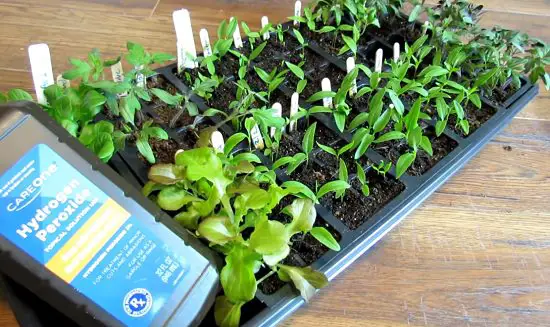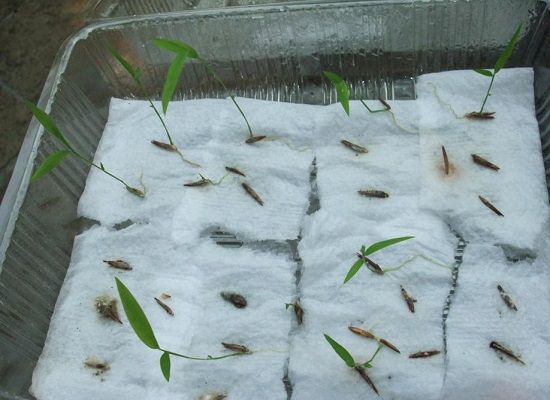Germination is one of the most vital courses of a plant’s life cycle, and Soaking Seeds In Hydrogen Peroxide gives this a head start!
If you are propagating plants from seeds, it is necessary that the seeds germinate successfully and quickly. And to achieve all of that, there is no better way than soaking seeds in hydrogen peroxide. Why? Discover everything below in detail!
Reason Why Seeds Fail To Germinate

There are several reasons why seeds may fail to germinate. Below are some common causes behind seed germination failure:
- Poor seed quality: Low-quality seeds, either due to age or damage, may have a reduced ability to germinate.
- Incorrect storage conditions: Improper storage conditions, such as exposure to high temperatures, excessive moisture, or extreme dryness, can damage seeds and inhibit germination.
- Inadequate moisture: Seeds require a specific moisture level to germinate. If the soil is too dry or excessively wet, germination may be hindered.
- Unsuitable temperature: Seeds have specific temperature requirements for germination. If the temperature is too high or too low, germination may be delayed or prevented.
- Lack of oxygen: Adequate oxygen availability is crucial for seed germination. Poorly aerated soils or overly compacted soil can limit oxygen supply to the seeds.
- Lack of light: While some seeds require light for germination, others need darkness. If the light conditions are not suitable for the specific seed, germination may be affected.
- Seed dormancy: Some seeds have innate mechanisms that prevent them from germinating immediately. They may require specific environmental cues, such as a period of cold temperatures or exposure to fire, to break dormancy.
- Seed coat hardness: Some seeds have hard or impermeable seed coats, which can hinder water absorption and germination. Scarification techniques, such as mechanical scarification or chemical treatment, may be necessary to overcome this barrier.
What Is Hydrogen Peroxide?
Hydrogen peroxide (H2O2) is quite popular in horticulture. It has an extra oxygen atom than water (H2O). When its molecule breaks down, this extra oxygen separates from the water, acting as a supplement to plants.
It also helps germinate seeds successfully by making them absorb more oxygen.
Effect of Hydrogen Peroxide on Seed Germination

Hydrogen peroxide (H2O2) can be used to help break down the hard outer layer of seeds and increase the chances of germination.
1. Choose the Appropriate Concentration
A 3% hydrogen peroxide solution is commonly used for seed treatment. Higher concentrations may be too harsh and damage the seeds.
2. Soak the Seeds
Place the seeds in a container and add enough hydrogen peroxide solution to submerge them completely. Allow the seeds to soak for a specific duration, typically ranging from 12 to 24 hours.
Soaking Seeds In Hydrogen Peroxide for too long may harm them, so it’s essential to follow the recommended duration for the specific plant species.
3. Rinse the Seeds
After the soaking period, thoroughly rinse the seeds with clean water to remove any remaining hydrogen peroxide residue.
This step is crucial to avoid any negative effects that hydrogen peroxide may have on seed germination.
4. Proceed with Regular Germination Methods
Once the seeds have been rinsed, you can proceed with your regular germination method. Plant the treated seeds in a suitable growing medium, ensuring proper moisture, temperature, and light conditions according to the specific seed’s requirements.
It’s important to note that not all seeds need hydrogen peroxide treatment. Hard seed coats are more common in certain plant species, such as legumes, cucumbers, tomatoes, and melons, and these seeds are more likely to benefit from this.
Note: Not all seeds with hard coats necessarily require the use of hydrogen peroxide. Some seeds can naturally break dormancy through exposure to environmental factors like moisture, temperature, or light. Research the specific germination requirements of the seeds you are working with to determine if hydrogen peroxide treatment is necessary or not.




Can you please provide a botanical study on the effects of peroxide on germination of seeds?
No.
I tried this last year after watching a video.i decided to try it on half of my mature seedlings. and everything I used peroxide on as per your instructions died. It’s a good thing I did not use it on all of my seedlings just half so I lost half of my yield.
Don’t use pure hydrogen Peroxide, dilute 1 ounce of hp in 1 pint of water. I germinate 10yr old seeds this way. Soak in glass of mixture for 12hrs-24hrs, rinse then plant in your medium.
Hey mate if I use 3% hydrogen peroxide store bought, do I need to mix with water or do I just soak the seeds in the 3% peroxide as is straight from the bottle?
Dilute with water (1-2tsp per litre of water)
Search for ‘HOW TO CORRECTLY USE HYDROGEN PEROXIDE IN YOUR GARDEN?’ by ‘Garden Tips’ on youtube for other hydrogen peroxide uses
———————————————————————————–
Thanks Balcony Garden Web for the useful videos!
You’re supposed to use it on seeds. Not seedlings.
Why would you use hydrogen peroxide on seedlings? And how do you think the seedlings would survive this chemical?
I am cleaning the outside of my dry gourds with 100% HP. And a tiny dab of bleach spray it on the out sides and let it dry. Works like a charm
Thank you for this tip, Paige!
Hahaha plank.. it’s for use on seeds not seedlings- of course they will die as it’s an acid solution
I dip mine in solution and then plant them instead. I found the roots get tangled in the towel Doing it this way. I found that Dipping them in The solution and planting them worked just as good. I used small cups with holes in the bottom so it’s harder to over water them.
I would not soak seeds like Echinacea in 3% H2O2. Hydrogen Peroxide is pretty reactive on organic tissues. It’s actually not recommended to use in wounds any more because of how much damage it can do. Seeds with hard seed coats can stand 3% H2O2 for limited periods of time. But even for those seeds knicking/cutting the seed corner usually does the job. A safer method for Echinacea germination would be to dilute down to 1/8th (0.00375 % H2O2) dilution and soak for 12-24 hours similar what Andrew mentioned above in his 1/16th dilution. I’ve been growing Echinacea as a hobby since the early 1990s. 60 days cold stratification (in a damp paper towel in the fridge) is also important to cause the chemical changes in the Echinacea seed to get you to germination. I would never use 3% H2O2 on live plants of any age. It is too reactive. It has been used diluted to deal with fungus gnats but it is still risky to the plants.
I have trouble w fungus gnats. I’ve tried everything from nematodes to nearly killing my plants drying them out. I tried yellow sticky tape. I tried that mosquito larvae insecticide sprinkled lightly on the soil. I tried it in a recommended it in a recommended solution. No luck. I saw on browsing to try a 1:20 H2O2 solution. In 10 days the indoor gnats were nearly gone. The outside gnats I have greatly diminished. I’m slowing winning that fight. I also noticed that my plants looked perkier. I have luck w germination of different seeds. Even super hot peppers notorious for slow germination sprouted. Over past few decades I’ve been unsuccessful w moonflower seeds. I tried cold, soaking, nicking, sand paper w near zero germination. A few weeks ago I saw an article on 1:10 H202/water warm soaking w moonflower seeds. I soaked 16 seeds for 5 hours. I planted them in biodegradable peat pots filled w quality container soil, watered and forgot them. 4 days later 13 had germinated and first leaves were nearly out of seedcover. 14 days post planting all had true leaves at various stages. I began reading more. I saw articles by different respectable places who recommended stratification w H2O2. I’m a reader before trying things. I see lots of articles on H2O2 use for plants: hydroponics to prevent molds, root rot treatments and more. The one thing stressed is proper dilution of 3% H2O2. I can honestly recommended it for certain situations in proper dilution.
Use food grade Diatomaceous earth for the gnats, look it up
Hydrogen peroxide is a more effective tool for combating fungus gnats then DE. DE helps treats but does not cure.
I have used peroxide mixed with water to water plants at my garden center when plants have been in pots a long time. It definitely perks them and rejuvenates them. I only do this on occasions and when the plants just aren’t looking happy. I also use Epsom salt and water on occasions as well. They work.
Long term fan of huge peroxide use but it’s use on seeds is new to me
Does the use of hydrogen peroxide this way render the seeds non-organic?
No, it does not.
Rain water is a mixture of water, dilute H2O2 dilute carbonated water as well as nitrogen etc.
If you look up the composition of atmospheric air rain is a composition of all those gasses plus water.
so yes it’s organic tho a portion of the H2O2 is neutralized in the air by fungi and other particulates in the air there’s still a bunch that makes it to the soil.
This is why watering plants with rainwater works so well.
Used hydrogen peroxide 1:1 water and soaked the seeds for 5-7 minutes did wonders- it spouted well and seeds that were treated with hydrogen peroxide grew 3 tines faster and larger than those that were not soaked in h202
Which % of H202 did you use?
Konsentrasinya berapa ya
Which ratio of H202 to water should i mix with pepper seeds and which % of H202?
And for how long?
I recently started a jiffy seed tray, and tried using a 1:15 dilution of 3% H2O2 (~1/2 cup H2O2 to 7.5 cups water) to expand the peat plugs. I sowed a mix of seeds (kale, spinach, oregano, chives, peas, lettuce) and plopped them on a heat mat – the kale sprouted in under 24 hours, and all of the plugs except lettuce were showing active germination within 48 hours. Even the oregano (supposedly ‘slow an erratic’ looks like a little meadow of sprouts). Blew my mind – I’m used to waiting a week or two at least!
Thanks for the experience sharing. How long did you soak them for?
How many ML Hydrogen Peroxide to 1L Water?
ANYONE..?
Tried this with ghourds and pumpkin seeds?
Do you still clip the seed end or no if doing a peroxide soak? Thanks!!!😁
I tried it with watermelon and cantaloupe seeds. Just left it on a covered plate, and occasionally recovered with water until I had time to plant them. By a couple of weeks, they looked like they were itching to be planted. Both have been planted and they are bearing fruit.
English speakers use non-exact measurements: teaspoons; tablespoons; pints; cups… the gallon of the English which differs from that of the USA…
French speakers use international and exact measurements. Why; everyone has their own measurements?
Those units of measurement are “exact.” For example, one teaspoon equals exactly 4.92892 milliliters, one tablespoon equals exactly 14.7868 milliliters, et cetera.
metric measurements are common in most of the world, USA uses the older standard of the Imperial System (IS).
Converting from IS to metric would be very expensive so America keeps IS.
Metric is being taught in American schools and many containers are labeled in both standards.
Got a question, can I just soak seeds in 3% hydrogen peroxide or do I need to dilute it more?
I grow outdoors and in a grow tent. I’ve had success with H2O2 in combating fungus on soil in the grow tent and seed germination. Gnats I find come from certain soils like Ocean Forest and other in their line and have stopped using them for this reason. Most seeds I plant are planted direct soil in grow tent under lights then moved outside. H2O2 does speed up germination but only for some hard shelled seeds.
I wanted to respond to John as I work in healthcare. Peroxide is still widely used in wound cleaning but usually not past the first day or so as the solution breaks open new cell growth creating a delayed heal time. It is still very useful in certain situations. I’ve also used Peroxide to lower ph in ponds. So little is needed to create change and better than chemicals
Lots of uses if respectful of the dangers.
I tried this with starting my seeds and was stunned! I soaked overnight in 1 teaspoon hydrogen peroxide to 3 cups of water. After soaking I poured seeds into a coffee filter, in a colander, and then poured tap water over to rinse. I then folded the coffee filter with seeds spread and put them in marked zip top snack bags until I could plant.
In less than 2 weeks my squash, peppers, watermelon and sunflowers are 4-6 inches tall and I am having to repot since I can’t transition to the garden for another month.
This is now my go to plan! Thank you for sharing.
That sounds great! Congratulations! And thank you for the overgrowing the pot sizes warning, I’ll be sure to buy larger pots then :)
I just learnt about Hydrogen Peroxide, but ran out before I could trying soaking seeds. It worked great for seedlings (1 spray a day) and they all sprouted new leaves overnight and existing leaves became bigger :)
I place my seeds in a 1.5% h2o2 solution insidea jar with a lid. I shake the jar for 2 minutes then open it and plant the seeds. This kills any pathogens on the seeds.
Also a 1.5% h2o2 solution can be used to control root rot in many plants.